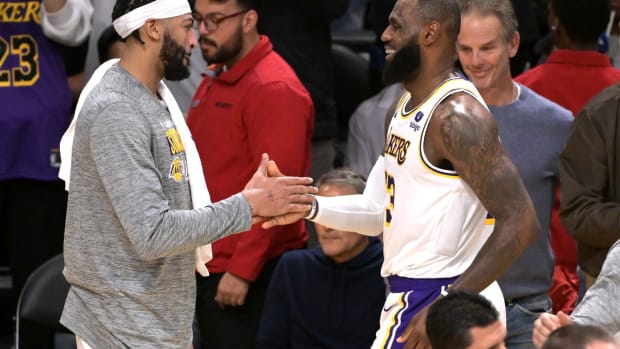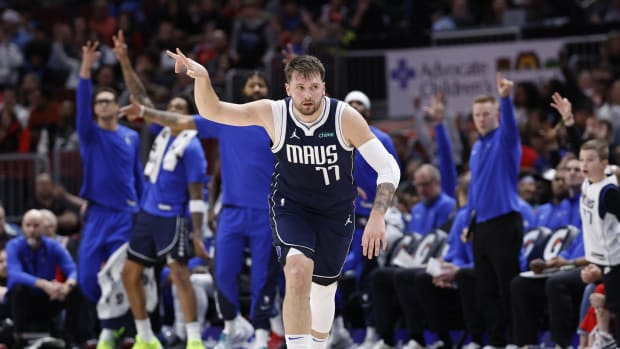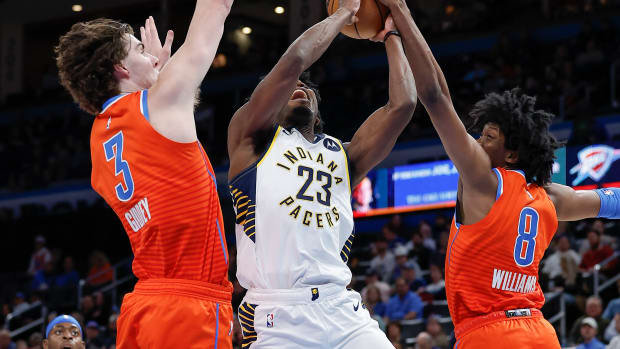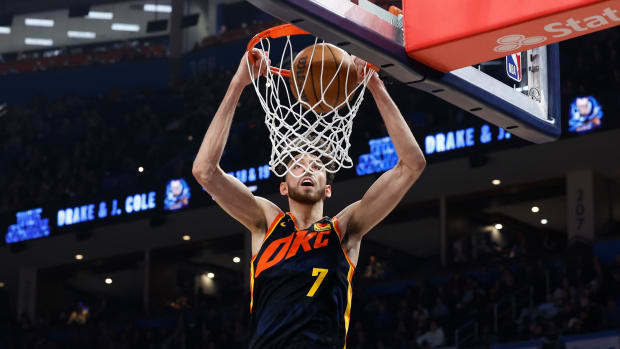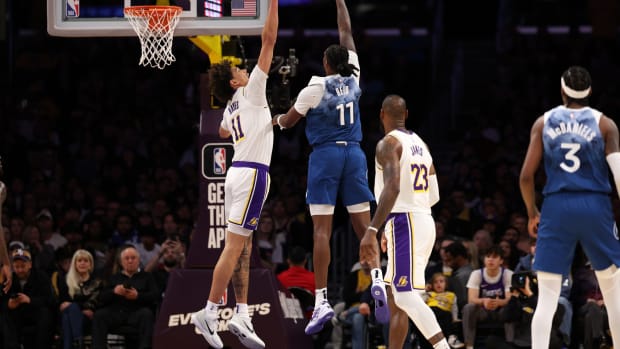For NBA Players, Nothing Good Ever Happens on Twitter After 11 p.m.
While the Clippers dispatched the Spurs in Los Angeles on Thursday night, the first winter storm of the season blanketed Manhattan. An unexpected six inches paralyzed the New York metropolitan area. Thousands of commuters lined around the block outside Port Authority, the busiest bus station in the country, when more than 1,100 scheduled departures were canceled. The George Washington bridge literally turned into a parking lot. And even following a night’s rest at home, the Clippers flocked to their local airport en route to Brooklyn for Saturday evening’s matchup with the Nets, only to endure several hours in delays, waiting on the tarmac for their east coast destination to clear through a backlog of cancelled flights from the day before.
Nearly 10 hours later, the Clippers finally arrived in New York Friday evening. A police escort shepherded the team buses to their hotel, and head coach Doc Rivers opted to organize a walk-through in a colossal ballroom. “If you’re an east coast team you probably would have done something this morning, a shootaround or something,” Rivers explained pregame Saturday afternoon. The Warriors typically shootaround the evening they land from a cross-country flight, allowing their players a full morning’s rest and a window to adjust to the new time zone before their primetime bouts. Rivers saw the same benefit leading into the Clippers’ 127-119 victory over Brooklyn.
“This morning we did nothing,” the veteran coach said. “It’s a tough way to start the first game [of a three-game road trip] but we’ve had some success when we’ve done that. When you try to wake your team up for an 11 o’clock shootaround, that’s 8 o’clock on their body clocks, which means they’re probably waking up at 6:30. That makes no sense. So, we choose to sleep and do less on the first game. Less preparation, which makes no sense in a lot of ways, but I’d rather have their legs than anything else, so that’s what we choose to do.”
FISCHER: The Wonky World of G-League Bus Driving
As the influence of data has permeated the league, sleep and player wellness has naturally demanded greater attention from team personnel. When Rivers coached the Celtics in the 2000s, Boston employed a sleep doctor. “Of course, the coaches didn’t listen or do what the sleep doctor says,” Rivers quipped.
Today, star players frequently rest on the second nights of back-to-backs. Coaching staffs, like the Clippers’ and Warriors’, are tweaking practice schedules to maximize time alloted for shuteye. Cheri Mah, M.D., a physician scientist at the University of California, has famously worked with players from Stephen Curry to Jeremy Lin. Last season, then-Hornets head coach Steve Clifford took a 21-game leave of absence, largely due to severe headaches doctors surmised were the result of chronic sleep deprivation. “If we keep reminding ourselves that sleep is a priority, hopefully we’ll benefit,” says Lauren Hale, Ph.D., a professor in Stony Brook University’s Program in public health, specializing in sleep and how it contributes in health disparities.
Hale, with lead investigator Jason J. Jones, PhD, an assistant professor of sociology at Stony Brook, published a new study this morning evaluating the association between late-night tweeting and next-day game performance among NBA players. Nearly half of Americans aged 18–24 are active on Twitter, and the league has certainly leveraged the social media platform during its current, prolific rise within pop culture. However, players tweeting in the wee hours of the night can function as proxy for labeling next-day games in which they are likely to be sleep deprived. A similar investigation was used during an attempt at mapping Donald Trump’s sleep schedule in Oct. 2017.
Previous studies have attempted to characterize the relationship between sleep and sports performance using small cohorts of athletes in controlled environments. Stony Brook’s research is the first of its kind to present time-dependent findings, providing the clearest evidence of a performance penalty following nocturnal tweeting activity, between 11:00 p.m. and 7:00 a.m. local time. The study analyzed 112 players’ tweets from 2009-2016, filtering 581,190 posts into a dataset of 37,073 late-night messages. After scraping in-game statistics from Yahoo Sports’ website, Stony Brook’s evaluation determined players score 1.14 fewer points and play two fewer minutes in games following late-night tweeting, as opposed to games not following late-night tweeting.
The biggest effect appears in shooting efficiency. On average, the 112 players shooting percentages ticked 1.7 percentage points lower in games following late-night Twitter activity, a decline from 45.35% to 43.65%. Even worse, when players tweeted between the hours of 2 a.m. and 6 a.m., shooting success rate dropped a staggering 3.6% overall. That may seem like an insignificant number.
Players like Clippers point guard Patrick Beverley balked at the correlation. “Hey man, next thing you know, if you don’t jump over a cat three days before the game, you ain’t gonna make two layups,” he said. Yet if all 11 players who played for the Clippers against the Nets shot 1.7% worse from the field, Los Angeles would have collectively converted two fewer baskets—the Clippers shot 48-95 from the field—and assuredly seen its eight-point, come-from-behind win become that much more of a nail-biter. “If two or three players are sleep deprived, that adds up,” Hale said.
FISCHER: Miles Plumlee Leans on Burning Man Experience to Lead Hawks
The shooting drop off even extends to 3.95% for players late-night tweeting on the road. Many teams have instituted evening guidelines for their players while they’re cooped up in a random hotel in a random city, often unsure of what day or time zone they’re currently in. "We have protocols in place,” Nets head coach Kenny Atkinson said. “I think it’s important and I think it’s gonna become more important. We talk about it. We present tips to our players.”
With video gaming becoming a prevalent twilight hobby in the league, staffs have suggested—and even purchased—players wear blue-light blocking glasses and goggles. Team nutritionists, like Marie Spano, who works for the Hawks, Braves and Falcons, are heavily involved in the process as well. The Hawks rely on a wellness questionnaire that originally determines how much sleep players experience, what time players go to bed and their level of caffeine use. Spano suggests her players add tart cherry juice into their diets. “It’s a natural source of melatonin,” Spano said. “Studies have shown sleep does improve when people drink tart cherry juice before bed.” She also recommends an after-hours cup of decaf tea, a natural source of the compound L theanine, which produces a dose-dependent relaxed state. Bolstering your general diet with magnesium-rich foods like almonds, pumpkin seeds, cashews and broad beans can also be a lubricant for better sleep habits.
Will Stony Brook's study dissuade players from roasting rival team accounts at 1:38 a.m. like Chandler Parsons? (He registered a DNP-Rest the following night in Salt Lake City.) Hale and her partners are aware that late-night tweeting doesn’t necessarily equate to sleep deprivation. Those tweets could have been scheduled or crafted by a social media manager. But Parsons’ burn, likely self-posted, has a lot of company. (C.J. McCollum had the next day off.) “I’m guilty of it too,” Hale said. “I stay up too late, whether it’s reading or social media. And that affects my daytime performance and I should know better.”
“Now it’s top of the priority list,” Atkinson said. “How we’re traveling, whether we’re staying over, not staying over, when guys are going to sleep on the plane, when we’re scheduling practice the next day on a long trip. It’s a big piece to this 82-game puzzle that we’re all still trying to figure out.”






























